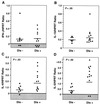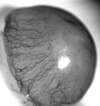Pathogenesis of onchocercal keratitis (River blindness)
- PMID: 10398675
- PMCID: PMC100248
- DOI: 10.1128/CMR.12.3.445
Pathogenesis of onchocercal keratitis (River blindness)
Abstract
Onchocerciasis is a major cause of blindness. Although the World Health Organization has been successful in reducing onchocerciasis as a public health problem in parts of West Africa, there remain an estimated 17 million people infected with Onchocerca volvulus, the parasite that causes this disease. Ocular pathology can be manifested in any part of the eye, although disease manifestations are frequently characterized as either posterior or anterior eye disease. This review focuses on onchocerca-mediated keratitis that results from an inflammatory response in the anterior portion of the eye and summarizes what is currently known about human disease. This review also describes studies with experimental models that have been established to determine the immunological mechanisms underlying interstitial keratitis. The pathogenesis of keratitis is thought to be due to the host inflammatory response to degenerating parasites in the eye; therefore, the primary clinical symptoms of onchocercal keratitis (corneal opacification and neovascularization) are induced after injection of soluble O. volvulus antigens into the corneal stroma. Experimental approaches have demonstrated an essential role for sensitized T helper cells and shown that cytokines can regulate the severity of keratitis by controlling recruitment of inflammatory cells into the cornea. Chemokines are also important in inflammatory cell recruitment to the cornea, and their role in onchocerciasis is being examined. Further understanding of the molecular basis of the development of onchocercal keratitis may lead to novel approaches to immunologically based intervention.
Figures








References
-
- Abiose A. Onchocercal eye disease and the impact of Mectizan treatment. Ann Trop Med Parasitol. 1998;92:S11–S22. - PubMed
-
- Baggiolini M, Dewald B, Moser B. Interleukin-8 and related chemotactic cytokines—CXC and CC chemokines. Adv Immunol. 1994;55:97–179. - PubMed
-
- Reference deleted.
-
- Breton B, Diagne M, Wanji S, Bougnoux M, Chandre F, Marechal P, Petit G, Vuong P, Bain O. Ivermectin and moxidectin in two filiarial systems: resistance of Monanema martini; inhibition of Litomosoides sigmodontis insemination. Parasitologia. 1997;39:19–28. - PubMed
-
- Chakravarti B, Herring T A, Lass J H, Parker J S, Bucy R P, Diaconu E, Tseng J, Whitfield D R, Greene B M, Chakravarti D N. Infiltration of CD4+ T cells into cornea during development of Onchocerca volvulus-induced experimental sclerosing keratitis in mice. Cell Immunol. 1994;159:306–314. - PubMed
Publication types
MeSH terms
Substances
Grants and funding
LinkOut - more resources
Full Text Sources
Other Literature Sources

